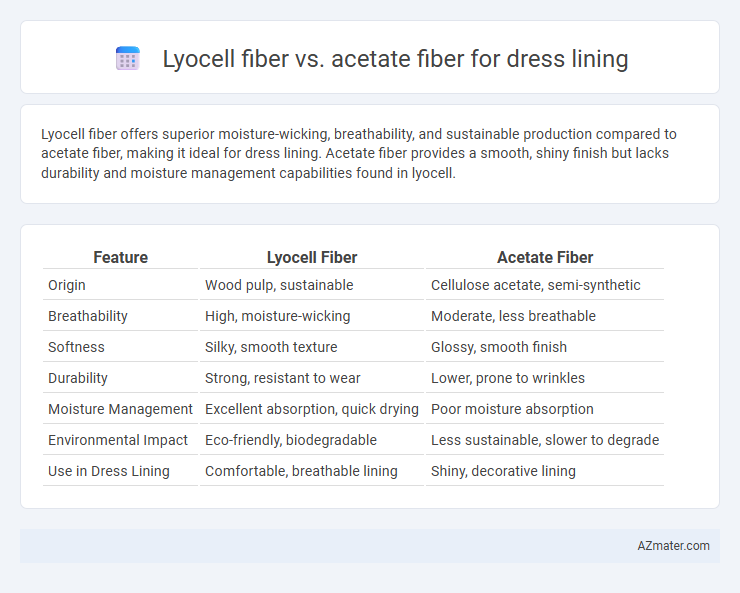Lyocell fiber offers superior moisture-wicking, breathability, and sustainable production compared to acetate fiber, making it ideal for dress lining. Acetate fiber provides a smooth, shiny finish but lacks durability and moisture management capabilities found in lyocell.
Table of Comparison
| Feature | Lyocell Fiber | Acetate Fiber |
|---|---|---|
| Origin | Wood pulp, sustainable | Cellulose acetate, semi-synthetic |
| Breathability | High, moisture-wicking | Moderate, less breathable |
| Softness | Silky, smooth texture | Glossy, smooth finish |
| Durability | Strong, resistant to wear | Lower, prone to wrinkles |
| Moisture Management | Excellent absorption, quick drying | Poor moisture absorption |
| Environmental Impact | Eco-friendly, biodegradable | Less sustainable, slower to degrade |
| Use in Dress Lining | Comfortable, breathable lining | Shiny, decorative lining |
Introduction to Lyocell and Acetate Fibers
Lyocell fiber, derived from sustainably sourced wood pulp, is known for its strength, breathability, and moisture-wicking properties, making it an excellent choice for dress lining. Acetate fiber, produced from cellulose acetate, offers a smooth, lustrous finish with excellent drape and color retention but is less durable and moisture absorbent compared to Lyocell. Both fibers provide comfort and aesthetic appeal in dress linings, but Lyocell's eco-friendly production and superior performance often make it a preferred option in modern textile applications.
Fiber Source and Manufacturing Process
Lyocell fiber, derived from sustainably sourced wood pulp, undergoes a closed-loop manufacturing process that recycles almost all solvents, minimizing environmental impact. Acetate fiber, produced from cellulose acetate derived primarily from wood pulp and cotton linters, is manufactured through a chemical-intensive acetylation process involving solvents that are less eco-friendly. Lyocell's eco-conscious production and renewable raw materials contrast with acetate's reliance on chemical treatments and less sustainable solvent recovery practices.
Environmental Impact and Sustainability
Lyocell fiber, produced from sustainably sourced wood pulp using a closed-loop process, significantly reduces environmental impact by minimizing water and chemical use compared to acetate fiber, which is derived from cellulose acetate involving more toxic solvents and energy-intensive production. Lyocell's biodegradability and lower carbon footprint make it a more sustainable choice for dress linings, promoting reduced waste and pollution. In contrast, acetate fiber's lower biodegradability and reliance on harmful chemicals contribute to greater environmental concerns during manufacturing and disposal.
Texture and Hand Feel Differences
Lyocell fiber offers a smooth, soft texture with excellent moisture-wicking properties, providing a breathable and comfortable hand feel ideal for dress linings. Acetate fiber has a silky, lustrous surface but feels less breathable and can be slightly slippery, impacting overall comfort. Lyocell's natural cellulose composition enhances durability and softness, whereas acetate's synthetic nature contributes to its luxurious sheen but less natural hand.
Breathability and Moisture Management
Lyocell fiber offers superior breathability compared to acetate fiber, making it a more comfortable choice for dress linings in warm conditions. Its excellent moisture management properties wick sweat away from the skin, promoting a dry and cool feeling throughout wear. In contrast, acetate fiber tends to trap heat and moisture, reducing overall comfort during extended use.
Durability and Longevity for Dress Linings
Lyocell fiber offers superior durability and longevity for dress linings due to its high tensile strength and resistance to abrasion, ensuring the lining maintains its integrity after repeated wear and washing. Acetate fiber, while smooth and luxurious, tends to weaken over time with exposure to heat and moisture, resulting in quicker deterioration of the lining fabric. Choosing Lyocell for dress linings enhances the garment's lifespan through improved structural resilience and sustained fabric performance.
Color Retention and Dye Affinity
Lyocell fiber exhibits superior dye affinity and color retention compared to acetate fiber, making it an excellent choice for dress lining that requires vibrant and long-lasting hues. Lyocell's cellulose-based structure allows it to absorb and retain dyes more effectively, resulting in bright, durable colors even after multiple washes. In contrast, acetate fibers tend to have lower dye affinity and colorfastness, often leading to fading and dullness over time in dress linings.
Comfort and Skin Sensitivity
Lyocell fiber offers superior moisture-wicking and breathability, making it highly comfortable and gentle for sensitive skin in dress linings. Its natural hypoallergenic properties reduce irritation and allow better airflow compared to acetate fiber, which can trap heat and cause discomfort. Lyocell's smooth texture enhances comfort by minimizing friction against the skin, ideal for prolonged wear.
Cost Analysis and Value Proposition
Lyocell fiber offers a sustainable and cost-effective option for dress lining due to its eco-friendly production and durability, often priced slightly higher than acetate but providing superior moisture-wicking and breathability. Acetate fiber, while generally more affordable upfront, tends to have lower durability and can suffer from static build-up, impacting long-term value despite its silky appearance and smooth drape. Evaluating cost per wear and environmental impact positions Lyocell as a premium investment for high-quality dress linings with enhanced comfort and sustainability.
Best Applications in Dress Lining Usage
Lyocell fiber offers excellent moisture-wicking and breathability, making it ideal for dress linings in warm climates and active wear due to its soft, smooth texture and high durability. Acetate fiber, known for its silk-like appearance and luxurious sheen, is best suited for formal and evening wear linings where an elegant drape and smooth finish are essential. Both fibers provide wrinkle resistance, but Lyocell excels in sustainability and comfort, while Acetate enhances visual appeal and smoothness in high-end garment linings.

Infographic: Lyocell fiber vs Acetate fiber for Dress lining
 azmater.com
azmater.com